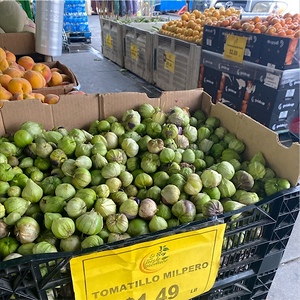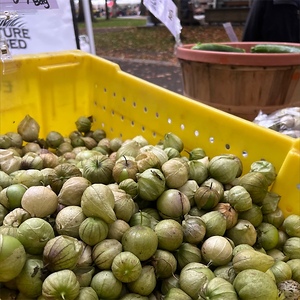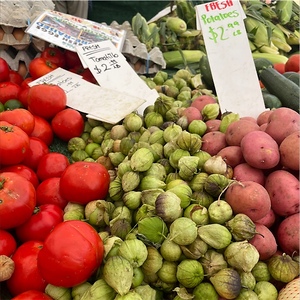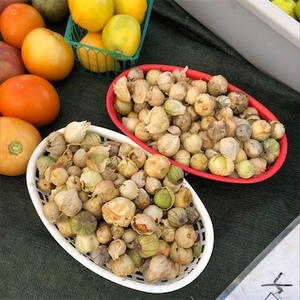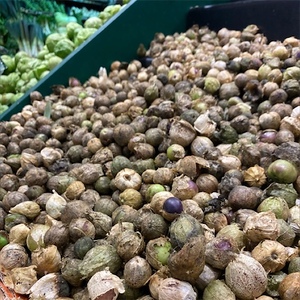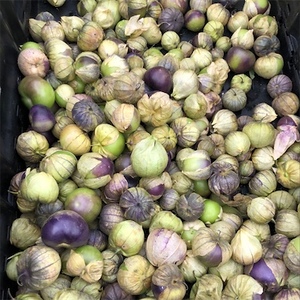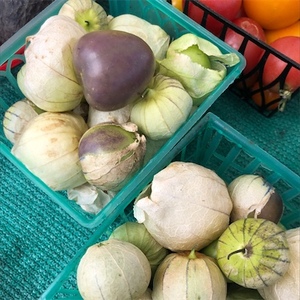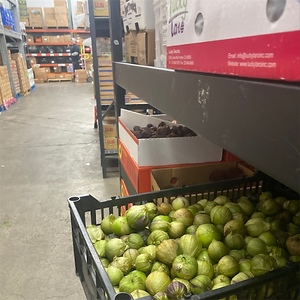

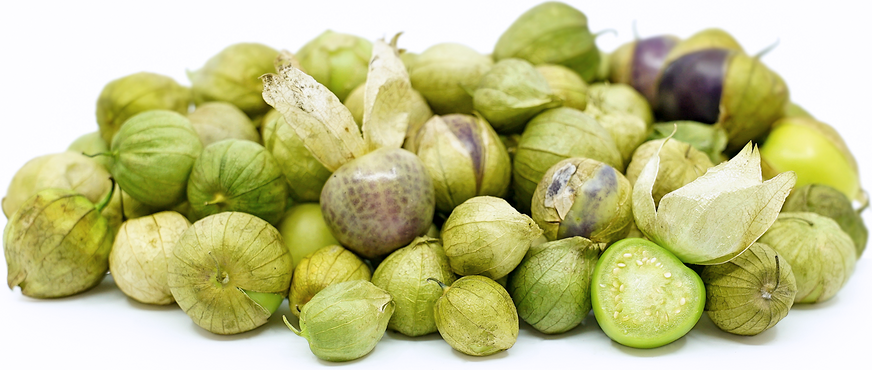
Milpero Tomatillos
Estimated Inventory, lb : 1.00
This item was last sold on : 07/31/25
Description/Taste
Milpero tomatillos are small, cherry tomato-sized fruits. They measure around 2.5 to 4 centimeters in diameter and have a circular shape. Milpero tomatillos are covered in a dry, parchment-like outer husk with vertical lines that run from top to bottom. This husk can be light green, dark purple, off-white, light brown, or a combination of these hues. The fruit's skin is similarly varied, appearing in shades of bright green, eggplant purple, or a variegated mix of both. This skin is hidden underneath the husk and has a firm, smooth, tomato-like texture. The light green flesh of Milpero tomatillos is dense, meaty, and has small white seeds running along the outer edges. This variety has a concentrated flavor with less intense acidity and a slightly sweeter taste than larger-sized tomatillos.
Seasons/Availability
Milpero tomatillos are available year-round.
Current Facts
Milpero tomatillos are botanically known as Physalis ixocarpa and are a member of the nightshade, or Solanaceae, family that also includes tomatoes, potatoes, and eggplants. The word milpero is derived from milpa, the Spanish term for cornfield. Milpero tomatillos, or tomatillos from the field, got their name because they are often found growing between rows of corn. The tomatillo species is native to Mexico and Central America where they are referred to by many names, including tomate Mexicano, Tomate Verde, Miltomate, Farolito, and Tomate de Cáscara. In English-speaking countries, tomatillos are called Chinese lanterns, Ground cherries, and Mexican Husk tomatoes. Milpero tomatillos are primarily used for their culinary value, particularly in Latin American cuisines.
Nutritional Value
The nutritional value of Milpero tomatillos isn’t widely recognized, but the tomatillos species are known to contain niacin, supporting energy metabolism and maintaining healthy skin and nerves. Tomatillos are also a good source of calcium and phosphorus, which work together to build and sustain strong bones and teeth. Their high levels of vitamin C help immune function and protect cells from damage, while their vitamin A content supports healthy vision and immune responses. The vitamin K in this fruit is also important for blood clotting and bone metabolism. Tomatillos provide dietary fiber that promotes healthy digestion, gut health, and balanced blood sugar and cholesterol levels. This variety provides the body with potassium, regulating blood pressure and heart health, as well as manganese and magnesium, nutrients that reduce inflammation and encourage energy production.
Applications
Milpero tomatillos are widely used in Latin and Mexican cuisine and are primarily employed in salsas and sauces, notably Salsa Verde. This fruit can be served raw, fried, baked, or roasted to heighten the flavor. They are often dried, pickled, preserved in jams, or canned for later use. Discard husks and wash thoroughly before eating to remove the sappy substance underneath this covering. They may be cooked into mole sauces, stews, soups, omelets, enchiladas, burritos, tacos, shakshouka, and gazpacho. When raw, Milipero tomatillos are often chopped into salads with ingredients like red peppers, corn, watermelon, red onions, mangoes, kiwis, and cucumber. Milpero tomatillos also pair well with garlic, serrano peppers, limes, cilantro, cumin, oregano, basil, vinegar, olive oil, chimichurri, steak, fish, and mozzarella, cotija, and ricotta cheese. Refrigerate husked fruits in a paper bag for up to one month or two weeks if the husks have been removed. Whole, sliced, or puréed Milpero tomatillos can also be frozen for later use.
Ethnic/Cultural Info
Milpero tomatillos may be used to create Salsa Verde, a green sauce that became a staple of Mexican cuisine during the Aztec Empire. Aside from tomatillos, this sauce is made with onions, jalapeños, green chilis, limes, and cilantro. The Aztecs used it as a dip for corn tortillas, but when the Spanish conquistadors arrived in Mexico, they added vinegar and sugar to the sauce to make it more appealing to European taste buds. Salsa Verde is traditionally used on Mexican dishes like huevos rancheros and enchiladas.
Geography/History
Milpero tomatillos are native to Mexico and descendants of the tomatillo species that were developed as a crop by the Ancient Aztecs. Tomatillos may have been used as far back as 800 BC, making them one of the oldest members of the Solanaceae family. Milpero tomatillos can be found growing in warm climates and are sometimes sourced from the wild in their native regions. They are also sown in gardens and produced commercially. This variety is most popular within their native regions but may be sourced from farmers’ markets and specialty stores in the Southwest of the United States or purchased from seed to be grown in home gardens.
Featured Restaurants
Restaurants currently purchasing this product as an ingredient for their menu.
| Estancia Adobe | San Diego CA | 858-550-1000 |
| Addison Del Mar | Del Mar CA | 858-350-7600 |
| Crudo Cevicheria & Oyster Bar | San Diego CA | 619-313-9127 |
| Viewpoint Brewing Co. | Del Mar CA | 858-205-9835 |
| 31ThirtyOne by Deckman | San Diego CA | 619-495-9814 |
| The Kitchen at MCASD | La Jolla CA | 619-880-8719 |
| Poseidon on the Beach | Del Mar CA | 858-755-9345 |
Recipe Ideas
Recipes that include Milpero Tomatillos. One







